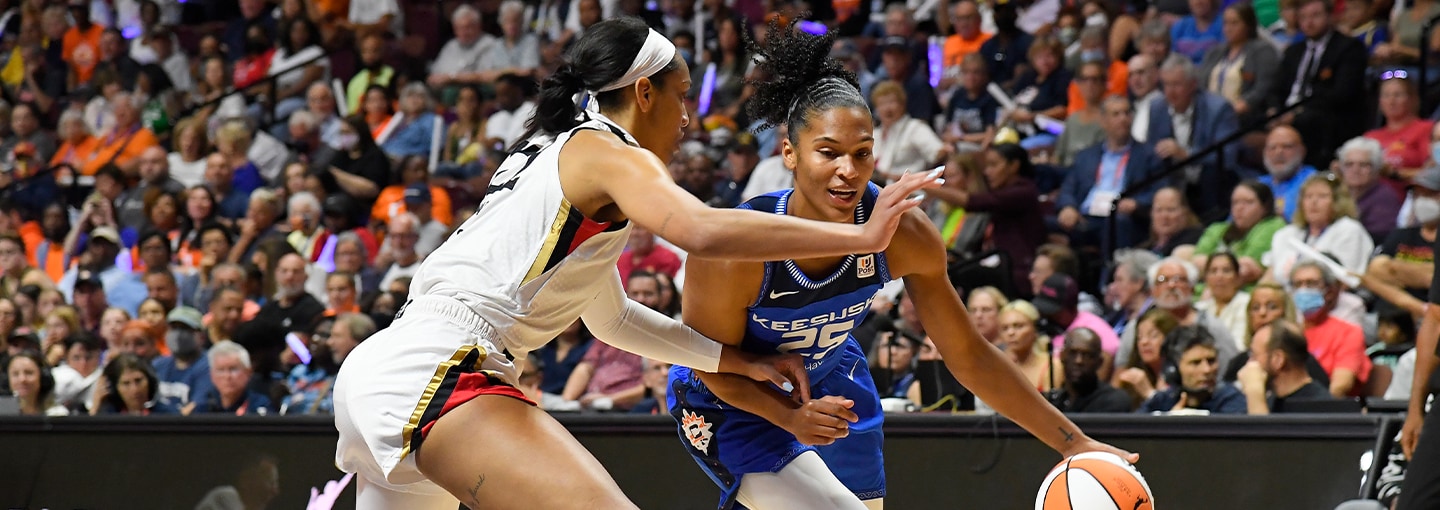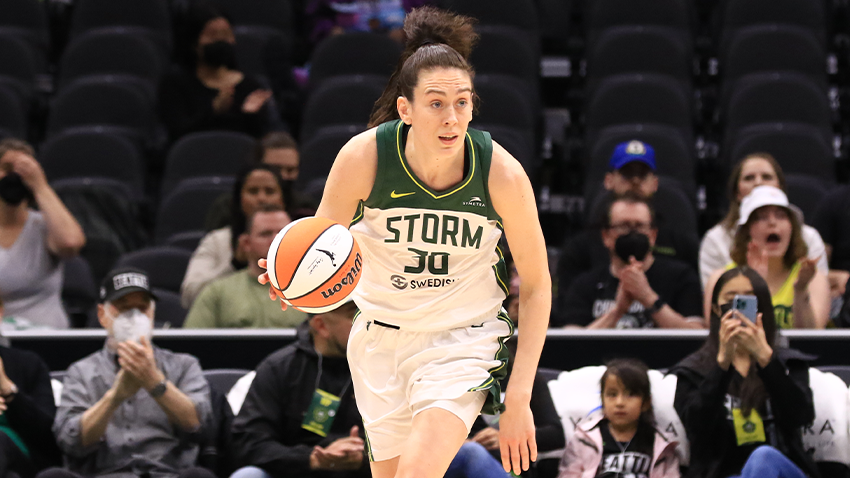Elite is Elite: The Art of Defense

As we’ve mentioned in the first few installments of Elite is Elite, offensive principles like spacing and pace significantly alter how the game is played in the WNBA. What makes that so exciting is watching how it impacts the other side of the ball. How do teams counter a more spread-out system? How does that affect the way lineups and rosters are built?
It’s harder to be a consistently positive defender than it’s ever been, making the elite of the elite stand out that much more.
With heightened intentionality in spacing the floor to create more open driving lanes to the rim, ground coverage is becoming an increasingly important skill.
Ground Coverage
It seems simplistic, but I’d log it as the ability to shrink space effectively with timely defensive rotations consistently. Some players have the mobility and length to act as a vacuum against offenses, cutting down a side of the floor like a wheat field. Still, consistency is the most important aspect of defense that unlocks what I would consider being elite. Can you do it almost every play? Do offenses have to account for your skillset because it’s a routine deterrent?
No one embodies this in the league more than Alyssa Thomas.
Thomas has a remarkable physical skillset, with supreme length, incredible functional strength, and great speed, making her legitimately capable of guarding every position on the court.
As the Sun have adapted after Brionna Jones’ injury, Thomas has played at the 5, becoming even more pivotal as the simultaneous safety net and the tip of the spear of the Sun’s defense.
Connecticut plays a reasonably aggressive scheme, deploying their frontcourt players closer to the level of the screen (near where it’s set) in ball screen coverage. Without consistent rim protection in the paint, the Sun opt to use their length, speed, and communication to halt the ball with pressure before it can get to the rim, making longer rotations on the back end if the opposition can paint the corners with quality passing.
Thomas has the skill set to be a great defender, but her blend of timing, aggression, and intuition make her, for my money, the best defender in the league. She calls plays out as they’re unfurling, beats offensive players to their spots, and muddies the offense by often outsmarting it.
Rim Protection
The Las Vegas Aces have made their mark this season through their defense, a catalyst of their transition game and a primary focus of the reigning champs. A’ja Wilson, the 2022 Defensive Player of the Year, has solidified the Aces as the backbone of a versatile and aggressive group.
Wilson is incredibly mobile at her size, with quick feet and a great ability to flip her hips and keep the ball in front, making her a fantastic defender on the perimeter for the 5 spot. The Aces have comfortability switching; they can play Wilson in a deeper drop (farther back in the paint near the rim), higher up near the free throw line, and honestly anywhere on the court.
In my opinion, this team’s defensive communication is the starkest change from last season, as they’ve found cohesion as a unit that they had at times last year but bring it to the table nightly now.
Adding Candace Parker, one of the great defenders in league history, and an increased role for Kiah Stokes (She is having a fantastic year!) has allowed the Aces to play with more size without sacrificing mobility on the court.
Wilson has mastered her timing over the past year and a half, maximizing herself as an off-ball roamer and making plays outside of plays because of her understanding of tendencies, picking the right spots to be aggressive, and being overwhelming with her length.
You don’t lead the league in blocked shots without a great understanding of positioning, and A’ja is a direct example of that. She’s always making minute changes in her positioning as a play goes on, which seems small, but doing that early work in a possession has led to her becoming the premier rim protector in the W.
Nail Help and Short Area Quickness
Where A’ja excels as a help defender, particularly in the paint, Breanna Stewart is her counterpart defending in help at the nail (~side of the FT line).
Stewart outright deters drives by being in a defensive stance and ball handlers opting to do something more productive with their time than drive into or towards her wingspan.
She has swift hands and closes gaps so quickly that shots that appear open often evaporate into tip blocks and a layup going the other way.
We talked about ground coverage with AT, but Stewie is the supreme short-area quickness defender in the game. What does that mean? Again, it sounds simple, but I’d consider it as her ability to lockdown and eradicate a pocket of space at a moment’s notice. That routinely stands out with her.
The Liberty rely less on hedging and blitzing ball screens (sending two to the ball when a screen is set) than the Storm did last season, but that was another way this played out. She’s a force jumping out with great positioning, timing, and overwhelming with her frame.
Everyone knows that Stewie has a long wingspan and excellent timing; she still finds ways to blow plays up as frequently as she does against offensive players who have played against her since her AAU days speaks to just how dominant she is and what makes her elite.
Many players have elite length, but few have the acumen that Stewart brings to the table to utilize it to the 100th percentile.
Screen Navigation
We hit on the value and importance of strength and screen navigation at the point of attack when talking about New York’s defensive infrastructure and Betnijah Laney’s impressive work on the defensive end.
Allisha Gray takes those principles to the max. She earned her first All-Star nod this season and seems a likely suitor for All-Defense honors at the end of the season if her play continues.
A handful of players can erase tight screens like Gray, making her a weapon in Atlanta’s defense. So much of being able to make things difficult out of ball screens is the ability to keep the ball in front of the defense. A screen is about opening up a pocket for the offense to exploit, and Gray is amongst the best in the league at squeezing that pocket by denying it entirely.
Perhaps my favorite nuance in her on-ball defense is her hands: It is rare to see her not have a hand or arm on her defender. Think of it like a jab in boxing. A jab isn’t about stopping a play. It’s about making things uncomfortable, making your presence felt, and setting up the potential for a turnover or contested shot.
Her motor, which never runs cold, tight footwork, and flexibility around traffic, is mesmerizing to watch.
There are many great defenders in this league, all worthy of recognition, and the players written about above set themselves apart with their greatness on the defensive end.
WNBA reporter Mark Schindler writes a column on WNBA.com throughout the season and can be reached on Twitter at @MG_Schindler. The views on this page do not necessarily reflect the views of the WNBA or its clubs.








,xPosition=.5,yPosition=.5)
,xPosition=.5,yPosition=.5)
,xPosition=.5,yPosition=.5)
,xPosition=.5,yPosition=.5)